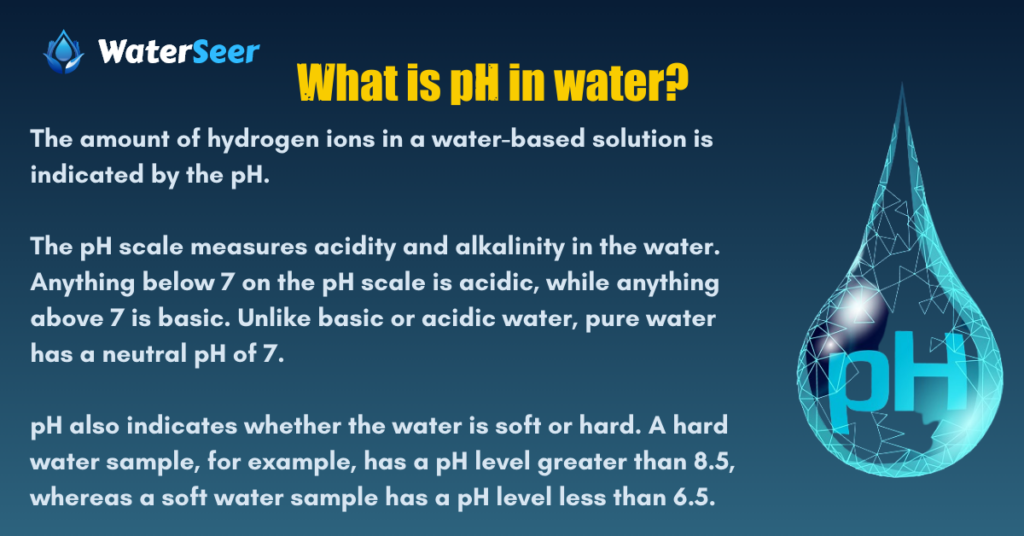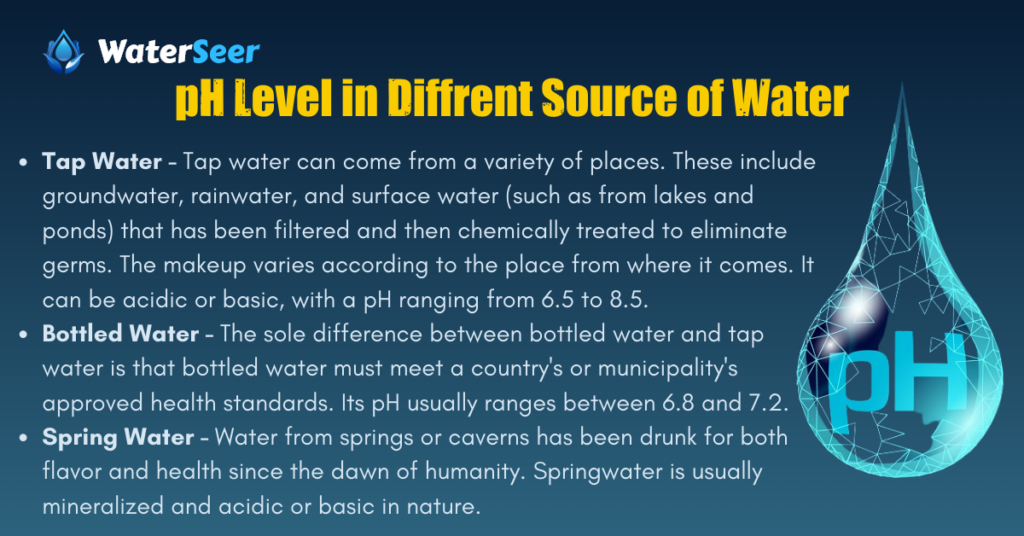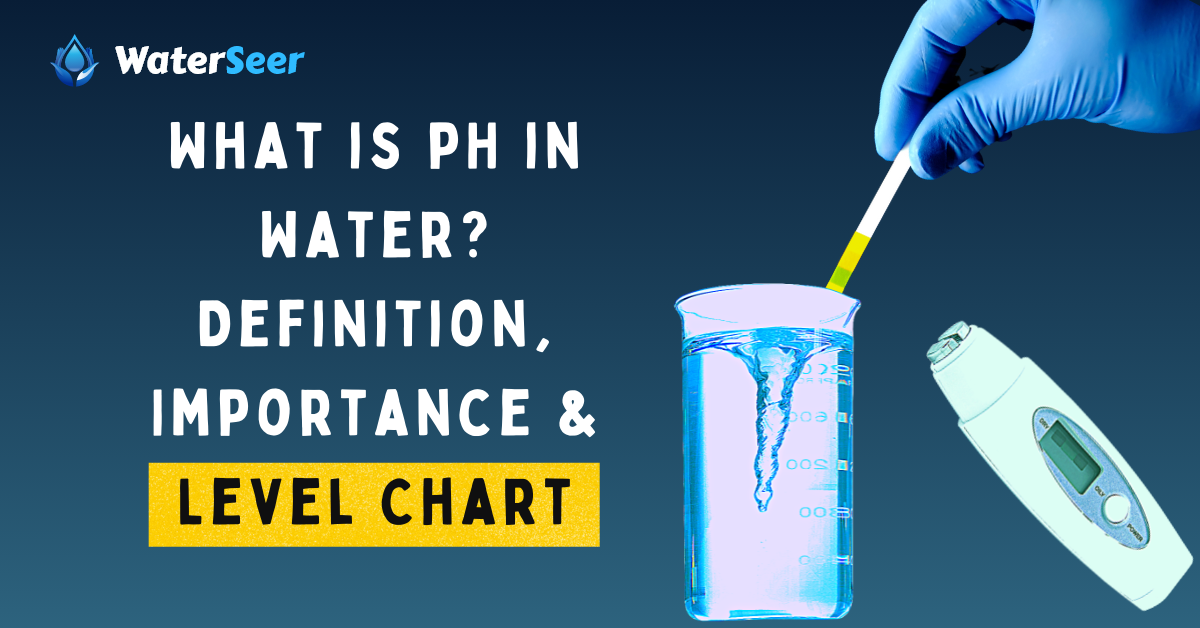All living species require water to survive. The pH level of completely pure water is 7, which is exactly in the center of the scale, making it a neutral drink. However, most water includes particles that can raise the pH from 6.5 (acidic) to 8.5 (basic or alkaline).
Surface water systems typically have a pH range of 6.5 to 8.5, whereas groundwater systems have a pH range of 6 to 8.5.
The Environmental Protection Agency (EPA) is in charge of testing pH levels in public drinking water in the United States. The EPA recommends that municipal water sources have a pH of 6.5 to 8.5.
How do you Get Pure Drinking Water?
Tap water goes through multiple purification processes before being delivered to the public. During this process, disinfectants like chlorine are added to the water to guard against germs.
As a result, there are various toxins you may not want in your body. In addition, carcinogenic disinfection by-products can also be created by chlorine in the water.
Drinking clean and filtered water regularly is one of the best methods to prioritize our health. Installing a water-filtering system in our home is one of the most efficient ways to do this.
In-home filtration protects against pollutants in the water continuously, especially in the case of an increase in contaminants. We may set a pH range and alkalinity level while installing a water filter.
Also Read:- Water Intoxication: How Much Water is Too Much Water?
What is pH in water?

The amount of hydrogen ions in a water-based solution is indicated by the pH.
- A pH of less than 7 implies more hydrogen ions in the water, making it acidic.
- A pH greater than 7 implies that the liquid has fewer hydrogen ions, making it basic.
The pH scale measures acidity and alkalinity in the water. Anything below 7 on the pH scale is acidic, while anything above 7 is basic. Unlike basic or acidic water, pure water has a neutral pH of 7.
pH also indicates whether the water is soft or hard. A hard water sample, for example, has a pH level greater than 8.5, whereas a soft water sample has a pH level less than 6.5.
What is pH Level?
The ‘potential of hydrogen,‘ or pH, measures the acidity or alkalinity of water-soluble compounds. The pH scale ranges from 0 to 14, with 7 being the neutral point. As the number falls below seven, acidity levels below seven rise, with 0 being the most acidic.
Values indicate alkalinity over 7, which increases as the number climbs, with 14 being the most alkaline. Pure water has no acid or basic properties. Distilled water has a pH value of 7.
Please notice the pH level chart, which shows that pure water’s pH is halfway between drain cleaner and battery acid.
Drinking Water pH Level Chart
| Type of water | pH level |
|---|---|
| Tap water | Varies; typically about 7.5 |
| Distilled reverse osmosis water | 5 to 7 |
| Common bottled waters | 6.5 to 7.5 |
| Bottled waters labeled as alkaline | 8 to 9 |
| Ocean water | About 8 |
| Acid rain | 5 to 5.5 |
This graph of pH levels is logarithmic and goes in powers of ten. Each incremental value represents a tenfold rise in acidity or alkalinity.
As a result, milk with a pH of 6 is 10 times more acidic than pure water with a pH of 7. Coffee has ten times the acidity of milk and one hundred times the acidity of water.
On the other hand, blood has a pH of 8, which is ten times higher than pure water, while the egg white is ten times higher than blood and 100 times higher than plain water.
Dissolved acids and salts are always present in water. As a result, water’s pH is more or less than 7. Dissolved salts give drinking water a mild flavor compared to purified water.
pH Level of Water

The standard limit for the pH level of drinking water is 6.5–8.5. This implies that the pH of drinking water should always be between 6.5 and 8.5, and you should never consume water that does not satisfy this standard.
- Tap Water – Tap water can come from a variety of places. These include groundwater, rainwater, and surface water (such as from lakes and ponds) that has been filtered and then chemically treated to eliminate germs. The makeup varies according to the place from where it comes. It can be acidic or basic, with a pH ranging from 6.5 to 8.5.
- Bottled Water – The sole difference between bottled water and tap water is that bottled water must meet a country’s or municipality’s approved health standards. Its pH usually ranges between 6.8 and 7.2.
- Spring Water – Water from springs or caverns has been drunk for both flavor and health since the dawn of humanity. Springwater is usually mineralized and acidic or basic in nature.
What Does a Changing or Unsafe pH Mean?
Weather trends, human activities, and natural processes all influence freshwater pH across the world. In addition, chemical or heavy metal contamination can cause water to have extremely low or high pH.
Water that isn’t in the “safe“ pH range of 6.5 to 8.5, especially if it’s alkaline, isn’t always dangerous. On the other hand, very alkaline water might have a disagreeable odor or flavor, as well as damage pipes and water-carrying equipment.
Water with a pH of less than 6.5 is more likely to be polluted, making it dangerous to drink. Metal pipes can also be corroded (dissolved) by it.
Many municipal water providers test the pH of their water voluntarily to check for contaminants, which can be detected by a change in pH level. In addition, water businesses treat their water to make it safe to drink again when contaminants are present.
Why Knowing the pH of Water is Important?
It is critical to understand the pH of drinking water. This is because water makes up around 60% of the human body. For example, an adult weighing 81 kg contains 48 kg of water.
Your body’s normal pH level is 7.4. Every sip of water and bite of food you take is either acidic or alkaline. It has an impact on the body’s delicate pH balance.
Understanding this impact is critical since blood pH must constantly be between 7.34 and 7.45. Furthermore, various pathological diseases may emerge if certain margins are surpassed.
What is the most significant amount of weight you consume? First, of course, there’s water.
The body needs at least 2 liters of water every day to operate normally. In hot weather, 4 liters of water are pretty common. Water is the most significant component of your daily diet.
As a result, it should come as no surprise that the pH of water is more significant than the pH of any other meal. For example, lemon juice has a pH of 2, although you eat significantly less of it than water. Therefore, you must pay close attention to the pH level of your drinking water.
Health Effects of pH in Drinking Water

What is the significance of pH? Deviation from the body’s normal pH substantially impacts the body’s homeostasis, stable balance, and biological activities.
- The pH level, like temperature, cannot move too far from the mean without causing harm to your body.
- Because you drink 2-4 liters of water every day, the pH level of your drinking water can have a significant influence on your health.
Health Problems Caused by Too Low pH (acidic)
- Stomach ulcer
- Gastritis
- Rheumatism
- Gout
- Oily skin
- Dermatological problems
- Hemorrhoids
- Chronic headache
Health Problems Caused by Too High pH (alkalinity)
- Kidney stones
- Constipation
- High cholesterol
- Dry skin
- Eczema
- Chronic cystitis
In general, stay away from mineralized spring water and cola. Tea and coffee should be used in moderation. Drink lots of water with a neutral pH. (6.8 to 7.2).
Tap water in many cities has a high pH. (up to 8). This is due to the chlorination procedure used in water treatment plants to remove microorganisms.
Apart from chlorine, tap water contains many minerals because it dissolves rust from the pipes it passes through.
Furthermore, due to the widespread use of pesticides and fertilizers leached into the water table, groundwater has turned acidic or alkaline.
How to Test pH at Home?
Municipal water providers typically do a decent job of maintaining a normal pH of approximately 7, so you shouldn’t have to perform any home testing.
However, if your faucets and pipes have become a rusty red, white, or blue tint, you should take action on your own. Like any discoloration in your drinking water, this tint is an indication of acidic water-induced corrosion.
Corroded pipes should be examined and, if required, replaced by a skilled plumber. Testing the pH of your drinking water at home is simple and affordable. A home test kit is all you’ll need. These are available in a variety of sizes and prices.
Water quality tester “pens” are among the most highly rated pH test items. Simply dip the pen into a sample of your drinking water and obtain an accurate pH value a few seconds later.
There’s no reason to worry if your water comes under the EPA’s suggested range of 6.5 to 8.5.
Conclusion
Make sure you’re drinking safe water. It must be devoid of excessive calcium and magnesium salts. The pH of tap water is far too high to support long-term general health. RO water is the safest type of drinkable water to drink out of all the options. It’s free of germs and has a pH that’s just right.

